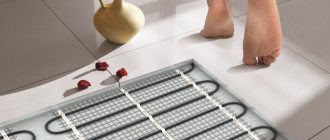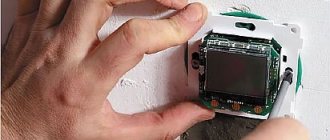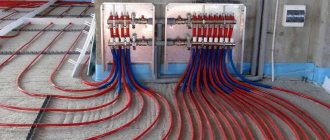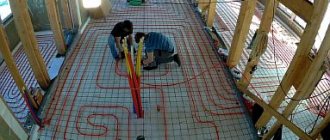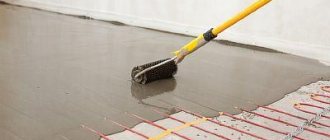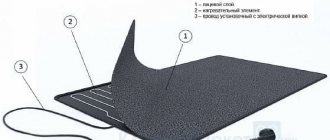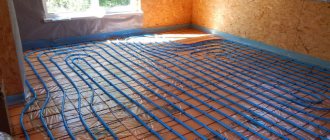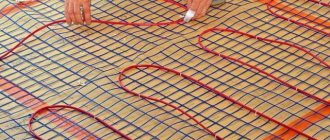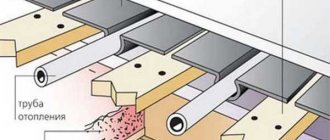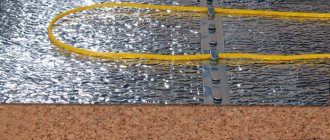An electric floor can have various modifications that differ from each other, for example, in design, methods of heat regulation and configuration. Therefore, the choice of system requires careful analysis. When choosing the equipment for a particular design, it is important to choose correctly whether it will be a single-core or double-core heated floor. First of all, it is necessary to understand the principle of operation of electric heating elements. The production of thermal energy is based on the properties of metals to generate heat when an electric current passes. Depending on the resistance value, the power can be adjusted. This parameter is affected by the material of the core and its diameter. The larger the cross-section, the more intense the heating will occur. But at the same time, electricity consumption increases significantly.
To make installation more convenient, and the system to be as durable as possible, already during the production process, the cable section at both ends is equipped with “cold ends” - power conductors made of copper.
Attention
You can only lengthen or shorten the cable itself, but not the copper ends.
If you are faced with choosing which underfloor heating element to prefer - single- or two-core, first you need to know the main characteristics of each of them, including the energy consumption of the heated floor for this option.
Types of electric heated floors
We can highlight the following list of varieties of electric heated floors:
- cable;
- film;
- rod;
- liquid.
In order to understand which heated floor is best to choose from this list, you should understand all the types in detail.
It’s worth starting the review with cable systems, since they have been on the market the longest. Such a system operates on a similar principle to water heated floors, the only difference being that the heat carrier is a heating cable, not pipes. After installation, the heating system is filled with cement screed and covered with a finishing floor covering.
After the temperature is set on the thermostat, the entire floor surface is heated to the specified values. The thermostat regulates the temperature according to readings from a temperature sensor built into the floor.
On the market you can find another type of heating system designed specifically for tiles - heating mats. They are intended for laying under a thin layer of mortar or glue. The mats consist of a mesh on which heat cables are placed at some intervals. This material is produced in rolls - for installation you just need to roll it out on the floor. The buyer has the opportunity to select heating elements with different heat output, based on their needs.
Another type of heated floors is film flooring. We will tell you which one to choose in this case below. The thickness of the heater in it, as a rule, is less than 3 mm, with a roll width of 500-1000 mm. Film is produced with different heat transfer rates. This type of heating element is designed specifically for installation under any floor covering without a screed, except perhaps tiles.
If we talk about what is better, a film or cable heated floor, then we can answer that the first option, since the manufacturer notes that in this case the heating element emits the most favorable long-wave soft heat for humans.
Rod heated floors are corner heaters connected to each other by conductors and forming a grid assembled into a roll. All carbon rods are independent, which means that if one of the elements stops functioning, there will be no need to open the screed, since the remaining sections will continue to heat the floor. This type of heated floors can be installed under a screed in any type of living space.
The list of floor heating types will be completed by a hybrid system that combines electric and water heating. A heating nichrome insulated core is placed in PE pipes with a heat-conducting liquid. On one side of such a cable there is a coupling, and on the other side there is a damper designed to compensate for the expanding liquid in a closed circuit.
conclusions
Each type of heated floor is good for its own purposes. If the house is built on USHP, then a warm floor may be the only heating method, and a very effective one. To do this, choose a water-heated floor, and if the house is not connected to gas and there are problems with solid fuel, cable electric. Film flooring is chosen for heating some comfort zones, stairs, passages.
Sources
- https://polcity.com.ua/blog-news/teplyj-pol-odnozhilnyj-ili-dvuzhilnyy
- https://AvtonomnoeTeplo.ru/teplye-poly/560-kakoy-kabel-luchshe-dlya-teplogo-pola.html
- https://OtoplenieBlog.ru/oborudovanie/teplyj-pol/kakie-harakteristiki-imeet-dvuhzhilnyj-tyoplyj-pol.html
- https://mr-build.ru/newteplo/dvuzilnyj-kabel.html/
- https://prestigpol.ru/odnozhilnyj-ili-dvuzhilnyj-teplyj-pol/
- https://teplospec.com/teplyy-pol/kakoy-luchshe-teplyy-pol-odnozhilnyy-ili-dvuzhilnyy-razlichiya-printsip-raboty-pravila-montazha.html
- https://MirCli.ru/teplye-poly/odnozhilnye/
- https://opolax.ru/teplye-elektricheskie-maty/dvujil-nyie-nagrevatel-nyie-mat
- https://www.tproekt.com/odnozilnyj-ili-dvuzilnyj-teplyj-pol-kakoj-vybrat/
- https://www.forumhouse.ru/journal/articles/8776-kakoi-teplyi-pol-vybrat-plyusy-i-minusy-infrakrasnoi-kabelnoi-i-vodyanoi-sistem
[collapse]
How does installation work?
The next step after choosing the power is to determine the model of the heated floor.
Two types of products with fundamental differences in installation:
- integral mats with fixed heating elements;
- cables, which are installed with the required spacing.
How to choose? In standard rooms you can safely install mats. They can be either single-core or double-core cables. The second type will provide faster heating of the rooms. The larger the diameter of the conductor, the higher the temperature level will rise when the equipment is turned on at maximum.
The specifics of the installation of a single-core system provide for the mandatory closure of the circuit. Both ends of the cable must be connected to a power source. When the areas are large, it is convenient to lay them in a “snake” pattern, so this condition is difficult to comply with. But for a small room it is quite suitable. Moreover, the price of single-core systems is low.
For a two-wire heated floor, the circuits are closed using a different system. Two wires are connected at the ends. The thermostat is also powered when both wires of the heating elements are connected. The models are more complex and therefore more expensive. At the same time, they make it possible to solve the problem of insulating large areas.
Advice. The level of electricity consumption by a heated floor is directly proportional to its power. In this regard, it is necessary to correctly calculate the load on the electrical wiring. If there is a discrepancy, the wiring must be replaced.
If the room has a complex configuration, then a two-wire heated floor will solve the problem, since there is no need to return the cable back to the thermostat. The equipment installation process will take about 4-5 hours, no more.
It is believed that both options for heated floors are harmless to humans. However, a two-core cable for underfloor heating creates an electromagnetic field 300 times less than the permissible standard, a single-core cable is 60 times less. For this reason, in large kitchens and living rooms, where people stay longer than in other rooms, it is more advisable to use two-core cables. Single-core - in bathrooms, corridors and loggias.
When laying equipment, you should consider how much thermal energy will be lost into the subfloor. For example, in apartments and houses on the second floors and above, there is no need to construct powerful thermal insulation; a foil layer is sufficient. But above basements or on cold floors in households, the surface needs to be thoroughly insulated, otherwise some of the heat will go “to nowhere.” With heat loss, kilowatts of electricity are lost. Therefore, it is better not to skimp on floor insulation.
The nuances of choosing a heated floor in accordance with the characteristics of the heating cable
- The above connection diagram for a two-core cable, or rather the absence of the need to return its second end to the thermostat, greatly facilitates installation in rooms with a complex configuration. It is important that the entire installation takes no more than four to five hours.
- From the point of view of harm to the human body, both sex models are considered harmless. However, there are some subtleties here: the electromagnetic field created by a two-core cable is less than the permissible standard by a factor of 300, and a single-core cable by a factor of 60. Therefore, for rooms such as a kitchen or living room, where, as a rule, people stay for a long time, more often two-core floors are used. A single-core one would be more appropriate, for example, in a bathroom, on a balcony or in any other room where a person usually stays for a short time.
But what should you choose - single-core or double-core underfloor heating? It all depends on the specific thermal capacity and room parameters. For large areas it is best to install cables with 2 cores. Systems with low energy consumption can be equipped with a single-core heated floor.
© 2022 prestigpol.ru
Installation of a two-core heating mat
A two-core heating mat is laid on floor areas not occupied by furniture. Laying the mat begins from the location where the thermostat is installed. The laying route is drawn in advance, taking into account the following requirements:
- The two-core heating mat is laid in a convenient way without returning to the beginning of installation;
- When laying the mat, it should not intersect or overlap itself;
- The zigzag fastening of the cable to the mesh allows you to rotate it to any desired angle during installation. To rotate, just cut the mesh inside the cable loop and rotate the cable to the desired angle;
- Before laying the mat it is necessary to check it. Testing a mat involves measuring its electrical resistance. It is impossible to plug in an unwound mat into the electrical network;
- The thermostat is installed in a convenient place. But in such a way that it can be supplied with power, a cold cable for the mat’s power supply and a wire from the temperature sensor. The temperature sensor is included with the mat. It fits into an open cable loop, protected by a corrugated pipe;
- The laid and tested mat can be covered with a 3-centimeter screed or tiles laid with tile adhesive. Laying tiles is a priority when choosing a floor finish for a two-core heating mat.
Types of cable heated floors
The popularity of electrical systems is based mainly on features such as
- ease of installation,
- ease of use,
- durability,
- economic accessibility,
- possibility of quick temperature adjustment.
In addition, in many cases, the use of similar equipment connected to a heating or hot water system is associated with many problems, starting with the need to dismantle the floor, form a screed, lay pipes and ending with the need to obtain a special permit for such an installation (for apartment buildings with central water supply) .
Therefore, when choosing equipment, the question arises about which film or cable underfloor heating is better. In the first case, it is assumed that a flexible film is used, which is an infrared heating element, in which carbon strips are located, interconnected by copper busbars to supply power voltage.
Cable heated floor
Its advantage is the ability to avoid the installation of additional screed and lay the film directly under the floor covering without any difficulties in performing installation work. But at the same time, it is also worth highlighting such features of infrared systems as the need for a perfectly flat surface for installation in order to avoid damage to the film. In addition, the average service life of infrared heating materials is 5-10 years.
film heated floor
If you plan to install cable underfloor heating, the characteristics of the equipment are determined primarily by the heating power depending on the area of the room and its purpose
In addition, it is important how exactly the equipment will be used: as main or additional heating
electric heated floor
The operating principle of cable underfloor heating is based on the use of a heating cable (or mat) as a heat source. It is laid under a cement-sand screed. Then the floor covering is laid. As a result, a solid heating surface is formed, which has fairly high energy efficiency indicators.
Features of installation and operation of thermal film
To ensure that the infrared heating system works as long as possible, it is recommended to adhere to the following tips:
- When cutting a strip, you cannot cut diagonally or make a rectangular trim. It is prohibited to cut conductive strips;
- It is prohibited to place objects that can retain heat on top of the floor covering above the film heated floor, for example, thick carpets, large furniture without legs, etc. Such items will lead to overheating and failure of the system;
- heavy furniture and other objects should not be placed above the film material. Excessive pressure on the IR sheet may damage the heater;
- depending on what kind of floor covering is used, for example, laminate, simultaneous heating may be prohibited with combined heating;
- It is not recommended to lay film material close to walls and large furniture: it is necessary to retreat about 3-10 cm. The distance depends on the power of the heating elements.
Film electric underfloor heating, installation and step-by-step instructions with photo examples of which were discussed in this article, is an effective way to heat a home. If you reduce heat loss to a minimum and install the system correctly, then the costs of such heating will not be so high. In addition, heated floors are often installed only in bathrooms and toilets, which will not ruin the owner at all.
Related publications
- Read
- Read
- Read
- Read
- Read
- Read
Characteristics of single-core wire
Single-core cable is most often used as additional heating. It is installed for underfloor heating in small rooms, in the kitchen, bathroom or toilet. The heating intensity is not very high. If there is a need to provide heating in a large room, then it is necessary to provide a long cable and lay it in frequent turns on the floor.
- A single-core cable is a system based on one rod, a core. Electric current passes through it. When heated, it acts as a heating device. The core is made of brass, galvanized steel or chrome.
- The rod is wrapped in insulating material. It can be fiberglass, fluoroplastic, polyvinyl chloride shell. Use 3-4 insulating layers.
- A reflective screen is placed on the insulation. It is designed to block electromagnetic radiation. Most often a thin layer of aluminum is used.
- The outer sheath of the cable is a protective film made of fiberglass or cross-linked polyethylene. They use heat-resistant, water-repellent material that protects the cable from external influences, including mechanical ones.
It is recommended to use the “warm floor” cable system under hard floor cladding. Even though the heater will be under the screed, it can be very vulnerable. It is not recommended to use linoleum or carpet as a finishing coating. An additional hard layer will be required to reliably protect the cable. Fiberboard sheets or plywood are used as a protective layer. Cable heating is widely used in Moscow, in apartments and country houses.
If you place furniture on the floor without first protecting the cable, “wire locking” may occur. The bottom surface of a cabinet or sofa will contribute to overheating of individual sections of the cable. The system will automatically sense the increased load and may shut down.
To control this process, it is recommended to install several temperature sensors in the floor covering. This will allow us to determine in which area the temperature began to decrease. Furniture is installed on legs. It is recommended to maintain a distance of 5 cm between the bottom panel of the cabinet and the floor.
How to install underfloor heating?
Before starting installation, it is necessary to make a “warm floor” project. It indicates the power of the equipment. The data is calculated according to the norm: heating 10 m2 requires 1 kW of energy. If a two-core heated floor is used as additional heating, only 10% of the room should be heated for a full effect, then accordingly, the indicator will be different, 10 W per 10 m2.
We recommend: Features of installing heated floors Sun power
The cable is connected to electricity. The equipment passport must indicate at what voltage it operates. If the home electrical wiring does not provide for the use of high-power appliances, then it is recommended to install new wiring in the house. Some systems operate from 230 V. How is cable heating installed?
- The room provides space on the wall for installing a thermostat and an automatic device. A recess is made on the surface of the wall, which is equipped with a plastic box. It will contain electrical wires and a heating system control unit.
- Before laying the cable, it is necessary to level the base. A concrete screed is made and equipped with thermal insulation material. A damper tape is reinforced around the perimeter of the room. It will retain heat in the room and compensate for the expansion of heating elements during heating.
- If the room is located on 2 or more floors, then the thickness of the insulation can be 2-3 cm. It is recommended to use material with a reflective surface.
- On the marked area, mats are placed to which the cable is attached. The upper part of the mat is covered with a protective film. All elements of the system are connected one by one.
- If it is necessary to lay a separate cable, then metal tapes are installed on the thermal insulation for fastening. Sections are laid with a certain step. It is calculated using the formula: S room / L cable length.
- The ends of the wires must be insulated. For this purpose, shrink film is used.
- A temperature sensor is placed on the surface of the heated area. The distance from the wall to the sensor is 60 cm.
- The sensor and all wire outputs are connected to the network.
- Conduct system testing.
- A screed with a depth of at least 20 mm is laid on the floor.
Double-core heated floor
A single-core cable is laid in a “snake” pattern. A two-core wire can be placed in a “snail”. One end of the wire is connected to the mains. The other is insulated and left in the center of the heated floor surface. The distance from the walls to the cable is 5-10 cm. It is not recommended to lay wires under monolithic furniture.
The "warm floor" system has been used for many years. It has proven itself well in both country cottages and city apartments. Cable heating is not difficult to install. It is necessary to calculate the electricity costs associated with heating your home. The cable is used as additional heating in a children's room, in a bathroom, in a toilet.
We recommend: How to install heated floors?
YouTube responded with an error: The request cannot be completed because you have exceeded your quota.
- Related Posts
- What is a self-leveling heated floor?
- How to lay cable heated flooring?
- How does a flow meter for a heated floor collector work?
- How to lay a heated floor in a bathroom under tiles?
- What materials are suitable for waterproofing underfloor heating?
- Features of Korean heated floors
Installation Specifics
You can connect a heating mat with one core yourself; the main thing is to follow the order of work:
First you need to calculate the appropriate heating power. Taking into account the results of the acquired data, you can select a heated floor model. Make a diagram of installation and connection of power lines to the heating system. It is necessary to determine in advance the place where the temperature sensor and temperature controller (external water thermostat) will be located. A very important indicator of such a heating circuit is the energy consumption that an electric heated floor will spend
This indicator depends on the model, and also on the installation diagram
A very important indicator of such a heating scheme is the energy consumption that will be spent by an electric heated floor. This indicator depends on the model, and also on the installation diagram.
Heated floor screed
If we consider the last parameter, then the thickness of the concrete screed, which the heated floor will have to warm up, also plays an important role here. For example, for rooms with dry residential purposes, the thickness of the screed can be from four to ten centimeters. But if a high humidity regime dominates in the room, the screed needs to be made a little larger.
Installation diagram of single-core heated floor
Cable classification
For warm electric floors, you can use a two-core or single-core cable. They both can be successfully used in a heated floor system, but only separately. Each of them has its own design features.
Single-core. Here there is almost equal heat transfer along the entire length. The downside is that there is a possibility of local overheating of individual areas of the heated floor. As for installation, the single-core cable must be positioned so that one end and the other end are located at the same point. It should also be noted that single-core heated floors are best suited for installation in small rooms.
Single core cable
Twin-core. From the name it is clear that the cable has two cores. One of them conducts current, the other converts electric current into heat. When installing a two-wire cable, there is no need to install one and the other end of the wire at the same point. The big advantage of a 2-core cable is that it has an additional insulating layer, which makes it safe to use.
Cable with two cores
There are other types of cable for the “warm floor” system, but these two options are used most often. Now let’s talk in more detail about what two-core and single-core resistive heating cables are, and we’ll also find out which one is better.
Single-core electric floor heating system
You can hear and read a lot about how a single-core heating mat can only be used in non-residential rooms, such as greenhouses, industrial premises, etc. However, this is not true; a single-core heating mat can be installed in a residential building or apartment, especially such Warm floors are ideal for loggias, balconies, hallways or bathrooms.
Warm floors operate according to this principle: electricity passes from the installed thermostat through the heating core, and the floors begin to heat up. One and the other ends of the single-core wire are connected to electricity. Among the advantages should be highlighted:
- Economical. Electrical energy consumption is less than when installing a two-wire floor.
- Low price for a heating mat.
- Installation is not particularly difficult and can be done independently.
Heating cable requirements
If you rely on state standards, it is important not to forget about the following general requirements for a heating cable:
- If a heated floor system is to be used in an apartment, then it should be an additional, and not the main, source of heating.
- In wooden houses with a wooden base, you need to install a wire whose power will not exceed 2 kW.
- To heat ramps or stairs located outside the premises, a wire with a rated power of 4 kW is used.
- To install one circuit, it is necessary to use a continuous piece of cable. It is advisable to install one circuit in one room if its area does not exceed 25 m2.
- The transition of a wire from one room to another is not allowed. In the transition area it may simply break.
- To install the product, you must use only those spare parts and accessories that are sold with it.
Installation of a heating cable for a heated floor must be carried out in strict accordance with the manufacturer's instructions
Single-core or two-core underfloor heating: which one to choose?
This article will help you figure out which heating cable is better - two-core or single-core, what is the difference between a single-core heated floor and a two-core one...
Today, electric “warm floor” has become a very popular, convenient and affordable option for heating apartment and private houses. This system is widely used as the main or additional source of heat in any room. And this is completely deserved, because heated floors have a number of undeniable advantages:
- Creates an even temperature in the room, i.e. heat that rises evenly from bottom to top;
- Maintain a normal level of humidity, because... do not dry the air;
- They raise the floor level slightly, thereby not stealing any space at all.
- The heating level is easily adjusted using a special thermostat;
- The service life is practically unlimited.
There are many different types of electric underfloor heating, but the main distinguishing feature is the number of strands of the heating element. There are two options:
- single-core (with one conductive core);
- two-core (with two conductive wires).
Fig. No. 1 Differences between single-core and two-core underfloor heating cables
So, when approaching the choice of a warm floor, we are faced with questions: what is the difference between a single-core and a two-core cable? and which one to choose?
The heating element of a single-core floor is a cable with a certain diameter. The material for the manufacture of this single core is nichrome, galvanized, brass or other material. When electricity is applied to it, due to the resistance present in the material, the core heats up.
The main difference is that in a two-core design, the electromagnetic fields from the two cores cancel each other out. Also, two thermal conductors significantly increase the heating power of the system. Those. A two-core cable, compared to a single-core cable, is more energy-intensive and easier to install, because in this case, the circuit is closed at the end of the cable by connecting the contacts to each other.
Fig. No. 2 Installation and connection of a heated floor based on a two-core heating cable
The connection of a single-core heated floor, in contrast to a two-core one, is carried out through the supply of its two “cold” ends.
Fig. No. 3 Installation and connection of a heated floor based on a single-core heating cable
The energy consumption of a heated floor is one of the main indicators of a heating system, and it is determined by the power of the selected option and the design of the device, in particular, the height of the protective concrete screed. It is necessary to know that a warm floor will serve as the main or auxiliary heating system, since this is what determines the choice of a single-core or double-core cable. An important factor is temperature comfort. More powerful heating is usually provided by two-core heating elements. Depending on the time required to heat the floor, the required thermal microclimate will be regulated. If there are no special requirements for temperature conditions, then a single-core heated floor is quite suitable for you.
ProMart.by
Links:
— Single-core heating sections of underfloor heating in a screed
— Two-core heating sections of underfloor heating in a screed
All our articles
Disadvantages and advantages of various types
It is impossible to say unequivocally which cable is better - single-core or multi-core, because both of them perform their functions and are successfully used in different situations. It all depends on the project, the technical characteristics of the wire and the expected load on the wiring.
More detailed differences can be seen in the table below:
| Stranded wire | Solid wire |
| The structural features lead to differences in characteristics and scope of application: | |
| Flexibility class: 3−6 | 1 and 2, depending on the cross-sectional area and material of the cores. |
| Purpose: Temporary flexible connections | Fixed wiring. |
| Service life: less than 5 years | More than 30 years. |
| Ease of installation: high flexibility allows you to lay the wire anywhere with any plane deformations - bends, twists, and so on. | Difficult to install due to low flexibility. |
| High price. | Low price, more economical option. |
Thus, we can conclude that the advantages of each type of wire are revealed only in its field of application. For example, for movable connections of portable electrical appliances - kettles, irons and other “room” equipment, it would be better to use a more elastic wire with a stranded core and flexible insulation.
When laying a power cable for stationary use, you can, of course, also use a multi-core wire - it is more flexible and easier to install, but based on its service life it is unprofitable. Otherwise, you will have to change the wiring after five years. Therefore, in such cases it is better to use a monocore.
Why is the service life of a stranded wire so short even under gentle conditions? The fact is that small wires oxidize during repeated passage of current, which leads to a decrease in the working cross-section of the current-carrying core. If you continue to apply the same load to such a wire, it will eventually fail and burn out. A single-core cable does not have this degree of oxidation, and therefore lasts much longer.
So, summing up the information provided, we can give specific examples of use so that the question does not arise, which is better - stranded or single-core wire.
Stranded core is used in the following situations:
- Laying wires in pipes and special cable ducts (as well as in industrial and private buildings) for temporary use, especially if the wiring has to overcome a large number of bends and deformations during the installation process. For these purposes, the following brands of wire are used more often than others: PVS, ShVVP, PuGV.
- Connecting household appliances and any mobile electrical devices, as well as chandeliers, extension cords and non-stationary devices (KG cable, MGShV wires, GDP, PVS).
- Wiring in a car and connecting audio systems - brands with increased resistance to vibration are best suited for this: PGVA, KRPT, PTL200, PuGV.
- Cables for connecting telephone and Internet, as well as alarm systems and external television antennas - UTP, FTP, PKSV, KSPV, TPPEP, TRP.
As for the use of single-core wires, their scope of use is limited to laying in concrete walls (grades VVG, NYM, PuV, AVVG), as well as in mines, tunnels and pipes (armored cables AVBbShv, ASB, SKl), in electric transport (MF, MK, NLF) and inside liquid concrete to accelerate its hardening by heating (PNSV, APV).
Therefore, for wiring in an ordinary house or apartment, it is necessary to use inflexible monocore wires; the most popular brands of this type are VVG, VVGng, VVGng-LS and NYM. And in movable temporary connections, extension cords and home appliances, you will need to use a wire with stranded cores, as well as cables of the same type - PVS and SHVVP.
Self-regulating heating elements for heated floors
A self-regulating heating cable for underfloor heating has completely different characteristics and structure, which is based on two copper cores and a heating conductive matrix. The last part of the wire is key in its design. The design of the product assumes that all parts are connected to the electrical network in parallel between the batteries. The matrix will act as a regulating and heating part. The main parts are protected by braided shielding, thermal protection and an outer casing.
The cost-saving self-regulating cable for heated floors works using the technology of the same name. Its principle is to release heat only to heat the colder parts of the system. As the air temperature drops, the wire begins to generate more heat. When increased, the heating intensity decreases. You should not think that a heated floor with a self-regulating cable turns off when the desired temperature of the surrounding air masses is reached. No. It works all the time, the power just decreases. To turn the system off, special relays and thermostats are used to control the heating.
Select a cable for floor heating according to the following characteristics:
- released thermal power;
- permissible exposure temperature (maximum indicated);
- working temperature.
Lay a high-quality floor heating cable in the screed, under tiles and other finishing materials. It is widely used, resistant to loads and difficult operating conditions. And self-regulating products are also highly resistant to aggressive and chemical environments. You are familiar with all the physical and technical data of the cable for underfloor heating; which wire to choose will be determined by the operating features of the additional heating system, the purpose of the object and personal requirements.
Power calculation
First, it is necessary to determine whether a single-core or two-core heated floor will serve as the main or auxiliary heating system, since this is what primarily determines their choice. We will show with an example how to calculate heat losses in a room and the power of the heating elements that best suits the conditions.
Let us assume that for an ordinary two-room apartment, the total heat consumption, taking into account the corresponding heat transfer resistance coefficients of surfaces, is 6 kW.
Note: If the calculation is carried out for an auxiliary system, the power of the main one is also taken into account.
On average, for heating 10 square meters. m of living space should generate about 1 kW of heat. For example, when heating with the main heating is 90%, the missing 10% is compensated by the heated floor. That is, with our initial data, 90% is 5.4 kW and 0.6 kW is missing, of course, provided that the floors are heated throughout the entire area of the apartment.
This state of affairs is quite rare - most often heated floors are installed in specific rooms: in the kitchen, in the bathroom. To facilitate calculations, it is customary to use average power values for premises of this type:
- for kitchen and living space - 110-150 watts per square meter. m;
- for shower, bathroom - 140-150 watts per square meter. m
Another determining factor is temperature comfort. As a rule, more intense heating is provided by two-core models. The required thermal microclimate will be regulated depending on the time required to heat the floor. If there are no special temperature requirements, you can use a single-core model.
Energy consumption of thermal film
Before installing an infrared heating system, many often have a question: how much electricity does a warm electric floor consume?
For IR film, the power per 1 m² of floor surface is about 0.2 kW. Energy consumption will largely depend on the thickness of the screed, heat loss, and thermal insulation. To calculate the power consumed, use the formula: W=S*P*0.4,
where - S is the floor area of the room, P is the total power of all film elements, 0.4 is a coefficient that takes into account only the usable area for heating.
So, if the housing is not very well insulated, the film should be used with maximum power, for example, 0.2 kW per m². For a room of 20 m², the power consumption will be as follows:
W=20*0.2*0.4=1.6 kW/h.
Most often, such heating is used for about 7-10 hours a day, usually in the morning and evening. According to calculations, electricity consumption per day will be 15 kW, per month – 480 kW. And this is the power of only one room! It is enough to multiply the results obtained by your tariff to calculate the financial costs of such heating.
Electric option
When using the electric version of heated floors, there is no need to install additional equipment. This flooring is a simple and quite effective solution for any room.
What elements does it consist of?
Heated floor components.
Let's consider what components are used to assemble an electrical heated floor system:
- the heating element is the main component of the system, a conductor with a fairly high resistance, it heats up from the passing electric current;
- The heated floor temperature sensor is used to control the operation of the cable;
- thermostat – an electronic device for the ability to automatically control the floor heating process;
- mounting tape, used to secure the heating element;
- thermal insulation is designed to reduce heat loss and reduce energy costs.
Heat source
The figure shows the structure of two types of heating cables.
The cable is the main element of the warm floor of an apartment or house, which actually serves as a source of heat. Floor heating systems use resistive cables. It has constant resistance. The heat is evenly distributed along its entire length.
Like all other electrical appliances, the heating element creates an electromagnetic field. The question immediately arises: can it be used in a residential area? Let's try to figure it out.
There are two different types of resistive cable:
- single-core, with one conductive core;
- two-core, with two conductive wires.
They differ in that in a two-core design, the electromagnetic fields from the two cores cancel each other out. This is the difference between a single-core heated floor and a two-core one.
Right choice
Diagram of a heated floor with a two-core heating element.
In order not to make a mistake in choosing an option, you need to understand for what purpose which cable is used.
Single-core can be used for the device:
- heated floors in utility rooms where people are not present for a long time;
- for heating garages and outbuildings;
- for installing an anti-icing system;
- for a heating device for external steps;
- for heating industrial sites.
Twin-core shielded heating system for installation under tiles in tile adhesive.
The second advantage of a two-core heating system is the ease of installation compared to a single-core heating system, in which the second end must be returned to the connection point during installation.
Two-wire systems do not have such a need; they have a second end ready for connection. Clear instructions from the manufacturer, included with each electric floor kit, allow for proper installation in accordance with all the rules.
The single-core system has an advantage. This is undoubtedly its price, which is much lower than that of a two-core system. Inexperienced consumers often choose this heated floor option without thinking about why it is cheaper. It happens that a family has a limited budget and people decide that they will make do with this option.
Floor coverings also impose certain restrictions on the choice. For example, there is no point in installing a heated layer under a coating that has a thick rubberized base.
Types of heating wires
To properly install a heated floor, you need to correctly evaluate the house in which it will be installed, calculate finances, and also understand the types of heating wires that could provide the floor covering with the required temperature. There are several varieties of them, the main ones are resistance-type heating cables for underfloor heating and self-regulating heating wires. These two main types differ from each other in characteristics and operating principles.
Resistive variety
The heating element of a resistive cable is different in that the temperature it creates inside itself is the same in each section. It is evenly distributed throughout the cable and ensures a stable supply of heat to the floor covering. Unfortunately, this is not always useful, especially if the floor covering contains furniture made of materials that are negatively affected by heat.
In this video you will learn about installing heated floors:
Resistive floor heating cable can be single-core or double-core. The composition of the first type, when mounted under the floor, involves closing the second end of the wire to the thermostat, that is, it is necessary to close the electrical circuit under the installer. A two-core wire for a heated floor does not require such a prerequisite. It is enough to connect one end of it to the thermostat, which is especially useful for large areas or complex housing layouts.
The resistive cable is characterized by uniform heat transfer in each section. This property has positive qualities, but it is precisely this property that causes the ability to provoke overheating in any particular place. For example, part of the flooring is under the furniture. During the heating process, heat exchange occurs between the floor covering and the material from which the furniture is made.
This cannot be said to be a fire hazard, but excessive and prolonged heating can lead to property damage and failure of the cable itself. Therefore, at the project stage, when planning the location of the heating element, it is necessary to take into account that in places where furniture is placed it is necessary to reduce the amount of heating wire or not to install it in those areas at all. This will avoid further rearrangement of furniture and negative consequences.
Before installing a heated floor, you need to think through several nuances, for example, where the furniture will be placed
Solid wire
At the time of installation, a cable of this type assumes that both its ends converge at the point where the electrical circuit is closed. The characteristic feature of this design is that it has two ends that do not involve heating, and is connected to a temperature controller. A single-core cable has the following positive features:
- the maximum heating temperature is several times higher than that of the two-core version;
- low electricity consumption;
- economical purchasing.
https://youtube.com/watch?v=cZfbxYkEyn0
When choosing any heating moment for a warm floor, it is necessary to take into account that it is recommended to choose a single-core type of heating channel for public rooms or non-residential buildings. In a residential building, the bathroom, kitchen and hallway are suitable for this type of floor heating. The general installation diagram can be represented as follows:
- the unheated cable is first connected to the temperature controller;
- the main length of the wire is placed under the floor in the form of a “snake”;
- the second remaining unheated end is pulled into the initial connection and also connected to the thermostat.
Two-wire heating channel
This type of heating channel does not involve transferring back to the beginning of the second end of the cable. The electrical circuit is closed thanks to a special coupling, which is pre-mounted on one end of the wire. The advantages of this system are as follows:
- the wires are easy to lay, they do not require the return of the second end;
- it is possible to lay a heating channel of varying complexity;
- switching to the thermostat occurs on one side;
- the voltage passing through the wire does not affect the electromagnetic pulses.
Which is better - a single-core or two-core heating system?
Currently, there are different technologies for underfloor heating. However, only electrical systems are distinguished by a large selection of configurations and modifications. So what is better - a two-core or single-core heating mat, we will try to figure it out.
The heating element here is a cable; its diameter can vary. Heating of a single core occurs due to the resistance that appears when electrical energy is supplied to it
Therefore, it is important that the laid cable has high strength characteristics and is reliable
Such a wire has good insulation, therefore, if you connect it correctly, the heating core will easily withstand high temperatures, up to eighty degrees, and the insulating layer can withstand temperatures up to one hundred degrees.
A two-core cable has good power, which is several times higher than that of a single-core cable. Power is achieved through the use of multiple conductors. Their main advantage is ease of installation, and the circuit should only be closed on one side of the wire. But connecting a wire with one core is done using the method of supplying cold ends. It is easier to install a two-core heating system than a single-core one.
Results
To choose the right modification of a heated floor, you need to calculate the specific thermal capacity and room parameters. For large rooms, it would be better to choose a two-wire system. Single-core has less thermal output and, accordingly, less energy consumption.
When installing a cable electric floor, the height of the room will decrease due to raising the floor surface.
The cable underfloor heating system can be successfully installed under tiles, linoleum and carpet. It warms up the room well through laminate and natural stone. Regulators help to effectively distribute warm flows throughout the rooms, shielding the heating elements. If you need high-quality insulation of a house or apartment, warm floors will be an excellent solution.
Principle of operation
How does electric underfloor heating work? With any modification, the basis of thermal energy is the ability of metals to heat up when an electric current passes through it. The resistance indicator is responsible for the power characteristics. In turn, this depends on the material from which the cores are made, as well as their diameter. The larger it is, the more the cable will heat up. But you need to take into account that energy consumption will also increase.
For ease of installation of the system and its durability, the cable is equipped with copper power conductors at both ends.
On a note. If it becomes necessary to shorten the cable, its copper ends must not be touched.
In order to figure out which heated floor is better, single-core or double-core, you need to get acquainted with the performance characteristics of these modifications and energy consumption.
Explanation of names and abbreviations
Here is a collection of data with a breakdown of all the names of the main brands of cables used in the installation of wiring and the construction of electrical networks:
Based on the above, it is impossible to draw a clear conclusion which is better, cable or wire. Each of them has its own area of application.
The main thing is to correctly decide and clearly understand when you can use one type of product and when another. Each case has different optimal operating and installation conditions.
But the installation of home electrical wiring according to the PUE must be done only with cables (with the exception of assembling the panel).
